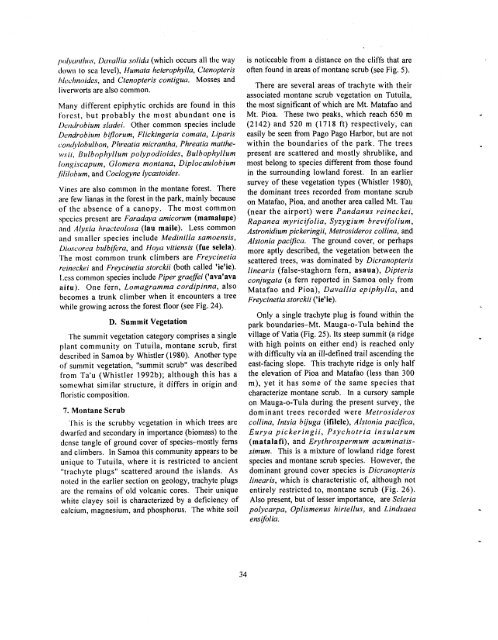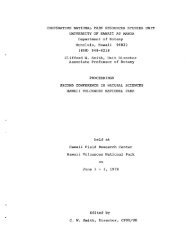american samoa - University of Hawaii at Manoa
american samoa - University of Hawaii at Manoa
american samoa - University of Hawaii at Manoa
You also want an ePaper? Increase the reach of your titles
YUMPU automatically turns print PDFs into web optimized ePapers that Google loves.
poIvon/l~os, Dtrvulliu solidu (which occurs all the way<br />
down lo sea level), Hum<strong>at</strong>a heterophylla, Ctenopteris<br />
hlcchnoides, and Ctenopteris contigua. Mosses and<br />
liverworts are also common.<br />
Many different epiphytic orchids are found in this<br />
forest, but probably the most abundant one is<br />
llcribobium sludei. Other common species include<br />
Dcndrobium biflorum, Flickingeria com<strong>at</strong>a, Liparis<br />
con~ylobulbon, Phre<strong>at</strong>ia micrantha, Phre<strong>at</strong>ia m<strong>at</strong>thewsir,<br />
Bulbophyllum polypodioides, Bulbophyllum<br />
longiscapum, Glomera montana, Diplocaulobium<br />
fililohum, and Coelogyne lycastoides.<br />
Vines are also common in the montane forest. There<br />
are few lianas in the forest in the park, mainly because<br />
<strong>of</strong> the absence <strong>of</strong> a canopy. The most common<br />
species present are Faradaya amicorum (mamalupe)<br />
and Alyxiu hracteolosa (lau maile). Less common<br />
and snialler species include Medinilla samoensis,<br />
IMscorca hulbifcra, and Hoya vitiensis (fue selela).<br />
The most common trunk climbers are Freycinetia<br />
reineckei and Freycinetia storckii (both called 'ie'ie).<br />
Less common species include Piper graeffei ('ava'ava<br />
aitu). One fern, Lomagramma cordipinna, also<br />
becomes a trunk climber when it encounters a tree<br />
while growing across the forest floor (see Fig. 24).<br />
D. Summit Veget<strong>at</strong>ion<br />
'The summit veget<strong>at</strong>ion c<strong>at</strong>egory comprises a single<br />
plant community on Tutuila, montane scrub, first<br />
described in Samoa by Whistler (1980). Another type<br />
<strong>of</strong> summit veget<strong>at</strong>ion, "summit scrub" was described<br />
from Ta'u (Whistler 1992b); although this has a<br />
somewh<strong>at</strong> similar structure, it differs in origin and<br />
floristic composition.<br />
7. Montane Scrub<br />
'l'his is the scrubby veget<strong>at</strong>ion in which trees are<br />
dwarfed and secondary in importance (biomass) to the<br />
dcnse tangle <strong>of</strong> ground cover <strong>of</strong> species-mostly ferns<br />
and climbers. In Samoa this community appears to be<br />
unique to Tutuila, where it is restricted to ancient<br />
"trachyte plugs" sc<strong>at</strong>tered around the islands. As<br />
noted in the earlier section on geology, trachyte plugs<br />
are the remains <strong>of</strong> old volcanic cores. Their unique<br />
white clayey soil is characterized by a deficiency <strong>of</strong><br />
calcium, magnesium, and phosphorus. The white soil<br />
is noticeable from a distance on the cliffs th<strong>at</strong> are<br />
<strong>of</strong>ten found in areas <strong>of</strong> montane scrub (see Fig. 5).<br />
There are several areas <strong>of</strong> trachyte with their<br />
associ<strong>at</strong>ed montane scrub veget<strong>at</strong>ion on Tutuila,<br />
the most significant <strong>of</strong> which are Mt. M<strong>at</strong>afao and<br />
Mt. Pioa. These two peaks, which reach 650 m<br />
(2142) and 520 m (17 18 ft) respectively, can<br />
easily be seen from Pago Pago Harbor, but are not<br />
within the boundaries <strong>of</strong> the park. The trees<br />
present are sc<strong>at</strong>tered and mostly shrublike, and<br />
most belong to species different from those found<br />
in the surrounding lowland forest. In an earlier<br />
survey <strong>of</strong> these veget<strong>at</strong>ion types (Whistler 1980),<br />
the dominant trees recorded from montane scrub<br />
on M<strong>at</strong>afao, Pioa, and another area called Mt. Tau<br />
(near the airport) were Pandanus reineckei,<br />
Rapanea myricifolia, Syzygium brevifolium,<br />
Astronidium pickeringii, Metrosideros collina, and<br />
Alstonia paczjlca. The ground cover, or perhaps<br />
more aptly described, the veget<strong>at</strong>ion between the<br />
sc<strong>at</strong>tered trees, was domin<strong>at</strong>ed by Dicranopteris<br />
linearis (false-staghorn fern, asaua), Dipteris<br />
conjug<strong>at</strong>a (a fern reported in Samoa only from<br />
M<strong>at</strong>afao and Pioa), Duvallia epiphylla, and<br />
Freycinetia storckii ('ie'ie).<br />
Only a single trachyte plug is found within the<br />
park boundaries-Mt. Mauga-o-Tula behind the<br />
village <strong>of</strong> V<strong>at</strong>ia (Fig. 25). Its steep summit (a ridge<br />
with high points on either end) is reached only<br />
with difficulty via an ill-defined trail ascending the<br />
east-facing slope. This trachyte ridge is only half<br />
the elev<strong>at</strong>ion <strong>of</strong> Pioa and M<strong>at</strong>afao (less than 300<br />
m), yet it has some <strong>of</strong> the same species th<strong>at</strong><br />
characterize montane scrub. In a cursory sample<br />
on Mauga-o-Tula during the present survey, the<br />
dominant trees recorded were Metrosideros<br />
collina, Intsia bijuga (ifilele), Alstonia pacifica,<br />
Eurya pickeringii, Psychotria insularum<br />
(m<strong>at</strong>alafi), and Erythrospermum acumin<strong>at</strong>is-<br />
simum. This is a mixture <strong>of</strong> lowland ridge forest<br />
species and montane scrub species. However, the<br />
dominant ground cover species is Dicranopteris<br />
linearis, which is characteristic <strong>of</strong>, although not<br />
entirely restricted to, montane scrub (Fig. 26).<br />
Also present, but <strong>of</strong> lesser importance, are Scleria<br />
polycarpa, Oplismenus hirtellus, and Lindsaea<br />
ens folia.
















